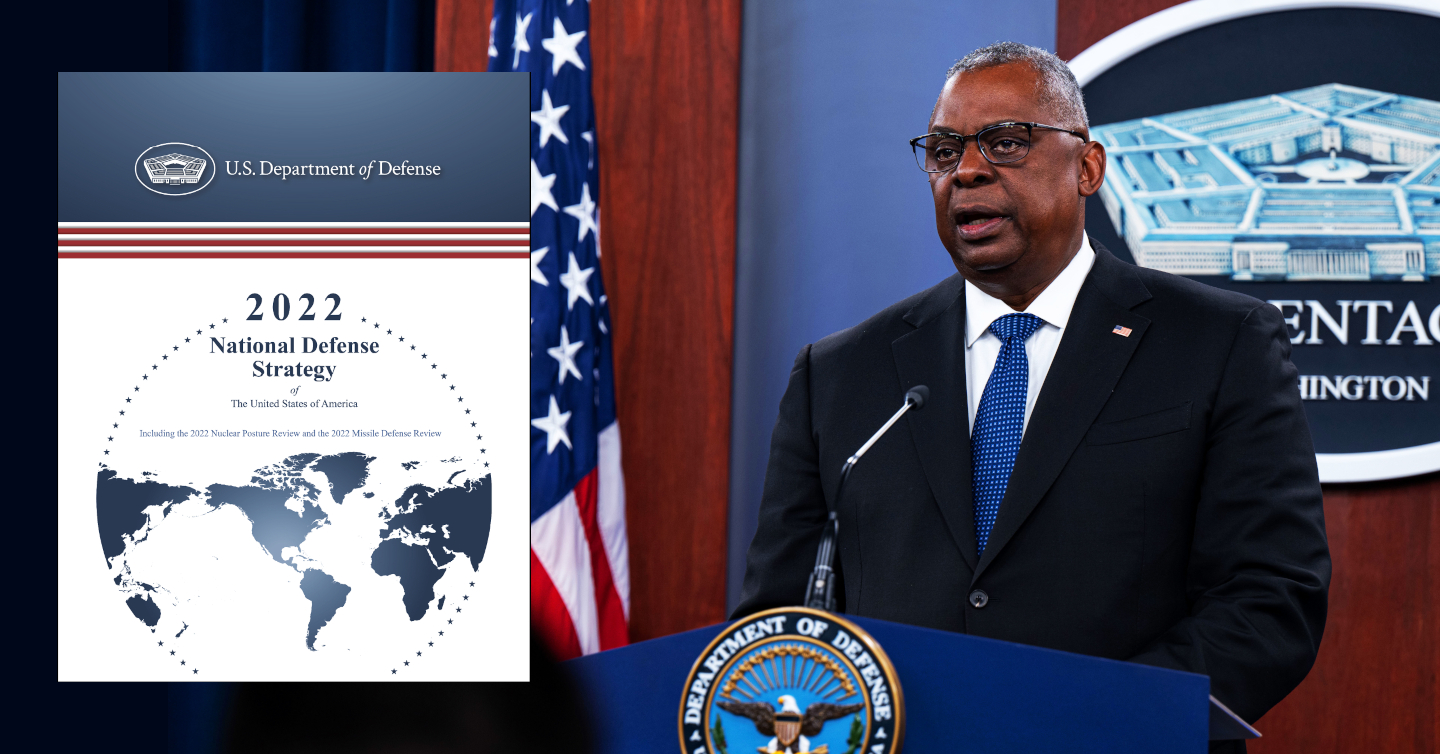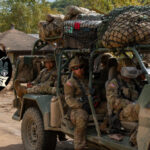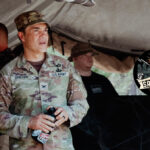
In October 2022 we published an episode examining the newly released National Security Strategy (NSS) and comparing it to its interim predecessor. Once the NSS is published there are a number of other strategic documents that are published that nest within the overarching guidance of the NSS. In this episode podcast editor Ron Granieri sits down with War College professors Bob Bradford and Tom Spahr to discuss the unclassified version of the 2022 National Defense Strategy (NDS). The capstone strategic guidance document for the Department of Defense (DoD), the NDS details priorities, identifies allies and adversaries, and spells out in grand macro terms the direction forward for the entire DoD. The analysis centers around the utility and the messaging of the document as well as the complimentary Missile Defense Review that was released along with the NDS. The three talk about plenty of familiar concepts like building partner capability and capacity, integrated deterrence and developing resilience that make for a great conversation.
If China is the pacing challenge, if Russia is an acute threat to the world environment, if we need to maintain resilience against future environmental challenges, then that clearly directs different types of investments that we might make.
Podcast: Download
Bob Bradford is the Associate Professor of Defense and Joint Processes and Henry Stimson Chair of Military Studies at the U.S. Army War College and is in his seventh year on the Carlisle faculty. Bob served 30 years as an officer in the U.S. Army, the last 20 as an operations research analyst supporting enterprise decisions.
COL Thomas W. Spahr is the Chair of the Department of Military Strategy Planning and Operations at the Army War College. COL Spahr has a Ph.D. in History from The Ohio State University and teaches courses at the Army War College on Military Campaigning and Intelligence.
Ron Granieri is an Associate Professor of History at the U.S. Army War College and the Editor of A BETTER PEACE.
The views expressed in this presentation are those of the speakers and do not necessarily reflect those of the U.S. Army War College, U.S. Army, or Department of Defense.
Photo Description: Secretary of Defense Lloyd J. Austin III conducts a press briefing at the Pentagon, Oct. 27, 2022.
Photo Credit: Navy Petty Officer 2nd Class Alexander Kubitza





Question: If “deterrence” stands at the heart of the new national defense strategy, then how does the U.S. (and our allies, partners, etc.) “deter” our great power and small competitors, “deter” our state and non-state actor competitors and “deter” our here at home competitors — ALL OF WHOM see “winning” more from the perspective of offering the populations of the world (to include the populations here at home in the U.S./the West) with governing models that are (arguably) (a) less politically and socially disruptive; this, than (b) the governing models offered by the U.S./the West?
(Herein, the governing models offered by the U.S./the West today, these such governing models are focused more on providing for such political, economic, social and value changes as are required to satisfy capitalism, markets and trade. Whereas, the governing model offered by our competitors today, these place capitalism, markets and trade — relative to such things as traditional social values, beliefs and institutions — more in a subordinate position.)
Note that — from the perspective I provide here — U.S./Western military forces — and those of our allies, partners, etc. — these such forces must be organized, ordered and oriented; this, so as to deal with (a) “opposing forces” (those both here at home and there abroad) who (b) see “winning” more from the perspective of offering the populations of the world the (arguably) better governing model that I describe above.
(“Pacing threats,” etc., to best be considered from this such perspective?)
Iam aggre with you
I will get to a “deterrence” question at the end of my comment here, but first this background:
Given the point of view that I present above, the “achieve revolutionary change” U.S./the West, in the New/Reverse Cold War of today, we face much the same challenges — and much the same “conservative” challengers — as did the “achieve revolutionary change” Soviets/the communists, in the Old Cold War of yesterday, and for much the same reason, as described below:
a. Challenges and Challengers Common to Both Cold Wars: “Conservative” both great powers and small challengers, “conservative” both state and non-state actors challengers and even “conservative” individuals and groups challengers within one’s own homeland — (a) all adopting containment and roll back strategies to use against you — and (b) all using such things as traditional social values, beliefs and institutions in their such causes.
b. Reason for Such Challengers and Challenges — Which is Common to Both Cold Wars: The extremely threatening and disruptive “achieve revolutionary change both at home and abroad” political objective of (a) the Soviets/the communists in the Old Cold War of yesterday (in the name of such things as socialism and communism back then) and (b) the U.S./the West in the New/Reverse Cold War of today (in the name of such things as capitalism, markets and trade now).
Bottom Line Question — Based on the Above:
The “conservative” competitors/opponents/enemies (those both at home and abroad) that the Soviets/the communists faced — in the Old Cold War of yesterday — these folks — (a) re: the Soviets/the communists “revolutionary warfare” — (b) countered with “resistance warfare.” Likewise:
The “conservative” competitors/opponents/enemies (those both here at home and there abroad) that the U.S./the West faces — in the New/Reverse Cold War of today — these folks — (a) re: our “revolutionary warfare” — (b) have countered with “resistance warfare.”
Question: How does one “deter” a “conservative” competitor/opponent/enemy — that you are threatening with your “revolutionary warfare” — from fighting back against you — using “resistance warfare?”
(Answer: You convince her/him that “resistance is futile?”)
Possibly the best example of “deterrence” that I have seen, this is the current effort that we see coming from nations such as China, Russia and others — who are seeking to “deter” the U.S./the West from (a) trying to transform world more along modern western lines and (b) trying to work more “by, with and through” the more “liberal”/the “pro-change” elements of the world to achieve these such goals. (Threat: If these such U.S./Western “revolutionary change” efforts are successful, this would cause a loss of power, influence and control by the current rulers/regimes of China, Russia, et. al.)
As a means of trying to “deter” the U.S./the West — from continuing to pursue these such goals — China, Russia and others determined that they would need to impose a “cost” on the U.S./the West — a “deterrence” “cost” great enough so as to cause the U.S./the West to reconsider whether (a) the potential “benefits” of our such desired “transformative” actions (see the paragraph immediately above); whether these such potential “benefits” were outweighed by the potential “cost” that the U.S./the West would have to pay in order to achieve these such benefits.
The manner by which China and Russia chose to pursue their such “deterrent”/their such “cost imposing” efforts, this was by (a) trying to transform the U.S./the West more along authoritarian lines and by (b) working more “by, with and through” the more “conservative”/the more “no-change” (and/or reverse already realized but unwanted change) elements of U.S./Western/etc., societies to as to achieve this such “deterrent” goal. (Threat: If these such Chinese, Russian, etc., efforts were successful, this would cause a loss of power, influence and control by the current rulers/regimes in the U.S./the West.)
If such things as the Brexit, the election of President Trump, the events of January 6, 2021, the rise of “conservatives” everywhere and the move to authoritarianism in many locales throughout the world are any indication, (a) the “cost” imposed on the U.S./the West by such nations as China, Russia, etc., these have (b) indeed been significant.
It remains to be seen, however, whether (a) these such “deterrent” “costs” have been sufficient; this, (b) so as to cause the U.S./the West to “cease and desist” (or at least to significantly reduce the size, scale and scope of) our — enduring — “transform the world more along modern western lines” agenda?
(Question: Does the new NSS and the new NDS address these matters?)
Note that — from the perspective that I provide in my comments above —
a. “Deterrence” for the U.S./the West,
b. This seems to relate only to “deterring” nations such as Russia and China from trying to achieve their “resistance to Western transformation” goals via military means.
With the possible exception of Ukraine and Taiwan, however, that (achieving “resistance to Western transformation” via military means), this does not seem to be the way that nations such as Russia, China, etc., “roll.”
Rather, the way that Russia, China, etc., seem to “roll” — in their more extensive efforts to “contain” and “roll back” the vast majority of U.S./Western “revolutionary change” efforts — this seems to be by working more “by, with and through” the natural enemies of “revolutionary change” — to wit: the more conservative elements of the states and societies of the world.
(This, after all, is the exactly what the U.S./the West did, in the Old Cold War of yesterday, when confronted with the Soviets/the communists trying to transform the world more along Soviet/communist lines.)
Question: Within our new NSS and new NDS, where do we address this such — much more extensive — and indeed much more threatening (see my comment immediately above) — non-military (or at least non-conventional military) approach being used by our competitors/our opponents/our enemies today?
Can you please clarify the NDS discussion and the word search on “allies” and “allies and partners” coming up 117 times (“allies and partners”) and “allies” alone 462 times? The NDS is within this combined document and ends on page 23 (p. 31 of pdf). The Nuclear Posture Review starts on p. 33 of the pdf.
Just looking at the NDS, which was the primary focus of this conversation, I found “allies” mentioned 56 times and “allies and partners” 46 times. What document are they referring to? Here is the link I am working from. https://media.defense.gov/2022/Oct/27/2003103845/-1/-1/1/2022-NATIONAL-DEFENSE-STRATEGY-NPR-MDR.PDF
Looking at Pam Boteler’s question above — which focuses on “allies” and “allies and partners” — should we not take time to address the security cooperation aspect of the new National Defense Strategy?
As a means of doing this, let us consider these excerpts from the book “Exporting Security: International Engagement, Security Cooperation, and the Changing Face of the US Military” by Professor Derek S. Reveron. (This book is said to serve as the anchor for the current Modern Wars Journal podcast “Slow Burn: How US Security Cooperation Shapes Operational Environments” which is [a] hosted by Benjamin Jebb and Barbara Elias and which [b] features retired Lieutenant General Mark Hertling and Professor Derek Reveron). Here are the quoted items:
“These combine with the enduring ideal of spreading the benefits of market democracy and a corresponding assumption that other democracies will embrace the US global agenda of opening markets, promoting civil liberties, and confronting organizations and states that seek to challenge the existing American international order.” (At the top of Page 2 of the Introduction chapter, of the book referenced above, look to the end of the paragraph that begins “As the United States looks ahead … ” The Amazon and Google Books websites will let you see these pages.)
“Since the 1990s the focus of American international security policy has been focused on creating conditions for extending zones of security and prosperity to other states under the theory that ‘political as well as economic globalization would make the world safer — and more profitable — for the United States.’ Consequently, the United States saw expansion, rather than retraction, of American military presence around the world. Indeed during Bill Clinton’s tenure as president, US military forces were deployed in more countries than at any time during his immediate predecessors’ tenure in the Oval Office, which coincided with the end of the Cold War. This trend has continued … ” (See the bottom of Page 2 and the top of Page 3 of the Introduction chapter of the above-referenced book.)
Question: Re: the new National Defense Strategy, can we say that (a) the basis for U.S./Western security cooperation discussed by Professor Reveron above, this (b) still serves as the basis for U.S./Western security cooperation today?